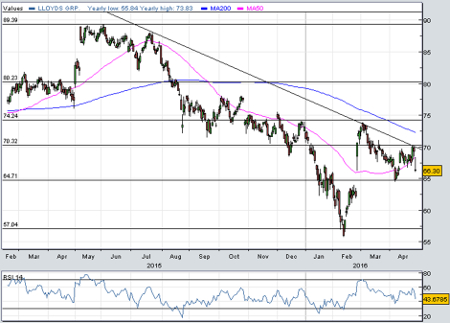Look past Lloyds' profit plunge
28th April 2016 11:56
shares are the most widely-owned in the UK. It boasts an army of small investors, hedge funds and institutional investors, and HM Treasury still owns almost 10%. Well-supported by City analysts, too, it's just made more money than expected in the first quarter of 2016, and there's a prospective yield of 8.4%. What's not to like?
Low interest rates are never good for bank sector margins because they limit the yield it can generate from cash deposited by customers. That partly explains the weak share price, although impairments, payment protection insurance charges and other fines have also put off buyers.
But the benefit of any future rate increase will drop straight through to the bottom line. In the meantime, latest results confirm Lloyds, under António Horta-Osório, is a well-run business with no "casino" arm to worry about, and the boss has reiterated guidance for the full-year.
Indeed, these results "demonstrate the strength of our differentiated, simple, low risk business model," said Horta-Osório Thursday, repeating the noble aim of becoming "the best bank for customers and shareholders".
Lloyds made an underlying profit of £2.05 billion in the three months to March, down 6% but still better than consensus forecasts. Strip out last year's contribution from TSB, which Lloyds has since sold, and profit was flat.

A 1% dip in revenue to £4.38 billion was disappointing, but that was down to "other income" - mainly lower insurance income and ongoing pressure on fees and commissions. Once you add back the £790 million used to buy back high-interest Enhanced Capital Note bonds, restructuring costs and a change in the difference between insurance policyholder liabilities and investments, profit plunged by 46% to £654 million.
An increase in net interest margin to 2.74% from 2.6% a year ago is better than expected, although a one-off credit helped here. However, Lloyds is sticking with its full-year target of 2.7%.
Its common equity tier 1 ratio of 12.8% was respectable, too, down just a couple of basis points, and the tangible net asset value per share increased by 2.9p quarter-on-quarter to 55.2p.
UBS analyst Jason Napier doesn't expect market earnings expectations to move on these numbers, but he likes an improvement in the cost:income ratio to 47.4% which "positions it up well to generate even more excess capital when income growth improves."
"With more than 25% capital upside to our 88p target price and 8.4% dividend yield forecast for this year, Lloyds remains our top pick in the UK banking sector".
On Napier's estimates for full-year reported pre-tax profit of £6.6 billion and earnings per share of 7.7p, Lloyds trades on a forward price/earnings ratio of just 9 times. A price/book value of 1.1 times for 2016 is hardly expensive either.
This article is for information and discussion purposes only and does not form a recommendation to invest or otherwise. The value of an investment may fall. The investments referred to in this article may not be suitable for all investors, and if in doubt, an investor should seek advice from a qualified investment adviser.
Editor's Picks